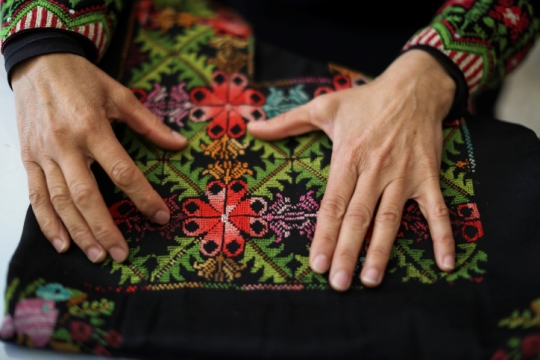An organization that settles Jews in the Negev, and with a central role in the story of displacement at Umm al-Hiran, enlists a famous Israeli designer to team up with Bedouin women for a NY Fashion Week fundraiser. The problem — nobody told the Bedouin women what they were up to.
Israeli designer Aviad Arik Herman, who made headlines earlier this year for designing Culture Minister Miri Regev’s famous “united Jerusalem” dress, entered into a blossoming “partnership” with Bedouin women culminating with a dress on display at New York Fashion Week this week, according to an article in Hebrew-language news site Ynet. The story, it turns out, is not as heartwarming as one might believe.
According to the article, the Or Movement enlisted Arik Herman to present an embroidered dress, designed by him and produced by the women of Laqiya. The Or Movement’s purpose is to settle the Negev and Galilee with Jews, and is behind the core “seed” community of Hiran, a Jewish-only town slated to be built on the ruins of an unrecognized Bedouin village called Umm al-Hiran.
So how did a group of women from unrecognized Bedouin villages, who are fighting to stop the demolition of their homes, come to cooperate with an initiative working to displace Beduoin just like them?
Asma al-Saneh, head of the The Association for the Improvement of Women’s Status, Lakia, the organization that runs “Desert Embroidery,” told me the Bedouin women had no idea in what they were taking part. “We never thought we would fall into such a deceitful trap. We never made headlines for our good work, and now this ruins our reputation.”
How was the contact made between you and the designer?
“A guy called and said he was a major designer and needed help. He came to us, at first alone, and introduced himself as a world-renowned designer who wants to present a dress in New York. He asked for help and brought the materials with him. He was a client like any other. He didn’t say he was making Miri Regev’s scandalous dress, and we had no idea who he was.
“Before he came to pick up the dress he asked if he could film. I thought it was good for publicity. I didn’t understanding who the people he brought with him were or why they were so silent. The next morning I woke up to that article on Ynet. If we had known, we would never have cooperated with him.”
Al-Saneh says that following the publication of the article and the reactions she received, she looked up the Or Movement and was horrified at what she found. Along with the organization’s founder, Na’ama al-Saneh, Asma consulted with a lawyer to find out what could be done. “We demonstrate in support of Umm al-Hiran. If they had told us they were going to raise money for this movement we would have refused.”
The article presents you as his partners, that you receive a percentage of his profits, and that at least one of you traveled to New York. Did you speak with him or ask for an explanation?
“I called and sent him messages asking how he could say such things in the media, and why he didn’t make clear who he was and what they were fundraising for. I wrote to him that if he was fundraising for Or then the Bedouin women deserve some of the money as well. That was before I even knew what Or does.”
“The director said to us that this was no problem, and that they would give us half of the donations. But I don’t want that partnership. A partnership should be transparent from the outset, not retroactively after a misleading article was published and only now they show all their cards.”
Na’ama says she is being attacked from all sides. Activists are accusing her and her organization of conspiring against the Bedouin. “Really harsh words were written about us, as if we are traitors. We were portrayed as if we sold our values for crumbs from the settlers.”
“I admit I did not look deeply into what that movement does and I didn’t ask too many questions. This was really all in good faith. I take responsibility,” she added.
So why did this happen? The original Hebrew-language article quoted the head of the Or Movement, Roni Palmer, and deputy Ofir Fischer, explaining: “We thought it would be appropriate, especially for New York Fashion Week, to show that there is a different kind of activity that connects the different populations, and together to embroider fabrics and dreams that create love and hope.”
Hope for whom exactly? Not for the women of Laqiya.
These women, who sought only to support themselves and their families with dignity, found themselves in the middle of a raging dispute over land, are exploited by an organization working in the service of an ideology that wishes to erase their culture and physical existence from the landscape.
Their embroidery will be featured on the body of a model walking a New York runway. Wealthy New Yorkers will spend serious money to promote the Judaization of the Negev and to be inspired by the novel idea of a “multicultural Israeli dress,” while bestowing the daring designer with glory he does not deserve. Meanwhile, the Laqiya women’s association and its members will stay in their unrecognized villages, and the price for the innocent mistake they made will continue to haunt them.
Asked for comment, the “Or” movement wrote: “The “Or” movement does not fight the darkness but as its name says, adds light. The movement works with all populations and sectors, including the Bedouin. The purchase of the dress from a designer from the Negev and the Bedouin women was meant to demonstrate that there is hope for shared living and coexistence between Arabs and Jews in the Negev and everywhere. We are sorry that there are extremist elements from the outside who are trying to present false facts, to sabotage, instigate and intimidate those who are working with these intentions. We who live in the Negev will continue despite the complexity to work together for a joint vision and action.”
Aviad Arik Herman declined to comment for this story.
A longer version of this article first appeared in Hebrew on Local Call. Read it here. Translated from the original Hebrew by Shoshana London Sappir.


